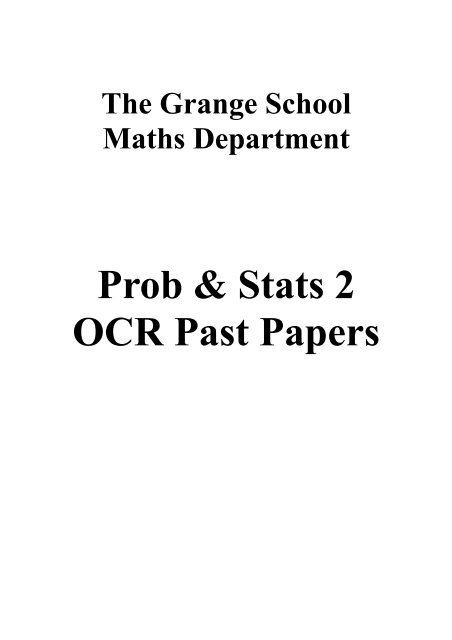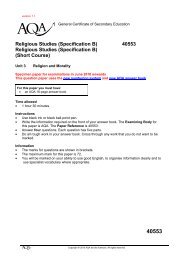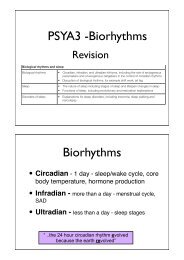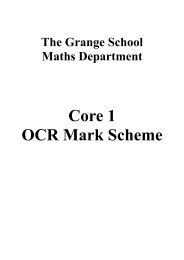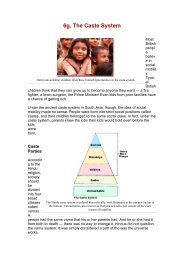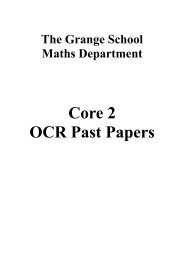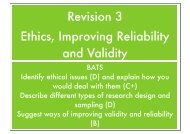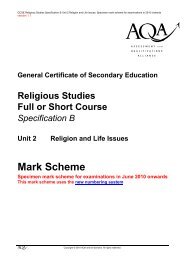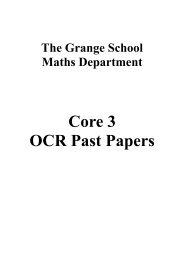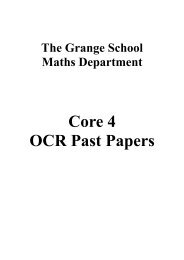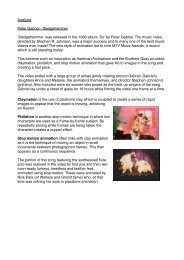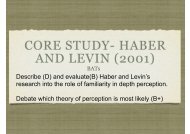Prob & Stats 2 OCR Past Papers - The Grange School Blogs
Prob & Stats 2 OCR Past Papers - The Grange School Blogs
Prob & Stats 2 OCR Past Papers - The Grange School Blogs
Create successful ePaper yourself
Turn your PDF publications into a flip-book with our unique Google optimized e-Paper software.
<strong>The</strong> <strong>Grange</strong> <strong>School</strong><br />
Maths Department<br />
<strong>Prob</strong> & <strong>Stats</strong> 2<br />
<strong>OCR</strong> <strong>Past</strong> <strong>Papers</strong>
Jan 2006<br />
2<br />
1 In a study of urban foxes it is found that on average there are 2 foxes in every 3 acres.<br />
(i) Use a Poisson distribution to find the probability that, at a given moment,<br />
(a) inarandomlychosenareaof3acresthereareatleast4foxes, [2]<br />
(b) in a randomly chosen area of 1 acre there are exactly 2 foxes. [3]<br />
(ii) Explain briefly why a Poisson distribution might not be a suitable model. [2]<br />
2 <strong>The</strong> random variable W has the distribution B(40, 2 ). Use an appropriate approximation to find<br />
7<br />
P(W > 13). [7]<br />
3 <strong>The</strong> manufacturers of a brand of chocolates claim that, on average, 30% of their chocolates have hard<br />
centres. In a random sample of 8 chocolates from this manufacturer, 5 had hard centres. Test, at the<br />
5% significance level, whether there is evidence that the population proportion of chocolates with hard<br />
centres is not 30%, stating your hypotheses clearly. Show the values of any relevant probabilities.<br />
[7]<br />
4 DVD players are tested after manufacture. <strong>The</strong> probability that a randomly chosen DVD player is<br />
defective is 0.02. <strong>The</strong> number of defective players in a random sample of size 80 is denoted by R.<br />
(i) Use an appropriate approximation to find P(R ≥ 2). [4]<br />
(ii) Find the smallest value of r for which P(R ≥ r)
3<br />
Jan 2006<br />
7 <strong>The</strong> random variable X has the distribution N(µ, 8 2 ). <strong>The</strong> mean of a random sample of 12 observations<br />
of X is denoted by X. A test is carried out at the 1% significance level of the null hypothesis H 0<br />
: µ = 80<br />
against the alternative hypothesis H 1<br />
: µ < 80. <strong>The</strong> test is summarised as follows: ‘Reject H 0<br />
if X < c;<br />
otherwise do not reject H 0<br />
’.<br />
(i) Calculate the value of c. [4]<br />
(ii) Assuming that µ = 80, state whether the conclusion of the test is correct, results in a Type I error,<br />
or results in a Type II error if:<br />
(a) X = 74.0, [1]<br />
(b) X = 75.0. [1]<br />
(iii) Independent repetitions of the above test, using the value of c found in part (i), suggest that in<br />
fact the probability of rejecting the null hypothesis is 0.06. Use this information to calculate the<br />
value of µ. [4]<br />
8 A continuous random variable X has probability density function given by<br />
where n and k are positive constants.<br />
f(x) ={ kxn 0 ≤ x ≤ 1,<br />
0 otherwise,<br />
(i) Find k in terms of n. [3]<br />
(ii) Show that E(X) = n + 1<br />
n + 2 . [3]<br />
It is given that n = 3.<br />
(iii) Find the variance of X. [3]<br />
(iv) One hundred observations of X are taken, and the mean of the observations is denoted by X.<br />
Write down the approximate distribution of X, giving the values of any parameters. [3]<br />
(v) Write down the mean and the variance of the random variable Y with probability density function<br />
given by<br />
g(y) ={ 4(y + 4 5 )3 − 4 5 ≤ y ≤ 1 5 ,<br />
0 otherwise.<br />
[3]<br />
4733/Jan06
2<br />
June 2006<br />
1 Calculate the variance of the continuous random variable with probability density function given by<br />
f(x) ={ 3<br />
37 x2 3 ≤ x ≤ 4,<br />
0 otherwise.<br />
[6]<br />
2 (i) <strong>The</strong> random variable R has the distribution B(6, p). A random observation of R is found to be<br />
6. Carry out a 5% significance test of the null hypothesis H 0<br />
: p = 0.45 against the alternative<br />
hypothesis H 1<br />
: p ≠ 0.45, showing all necessary details of your calculation. [4]<br />
(ii) <strong>The</strong> random variable S has the distribution B(n, p). H 0<br />
and H 1<br />
are as in part (i). A random<br />
observation of S is found to be 1. Use tables to find the largest value of n for which H 0<br />
is not<br />
rejected. Show the values of any relevant probabilities. [3]<br />
3 <strong>The</strong> continuous random variable T has mean µ and standard deviation σ. It is known that<br />
P(T < 140) =0.01 and P(T < 300) =0.8.<br />
(i) Assuming that T is normally distributed, calculate the values of µ and σ. [6]<br />
In fact, T represents the time, in minutes, taken by a randomly chosen runner in a public marathon, in<br />
which about 10% of runners took longer than 400 minutes.<br />
(ii) State with a reason whether the mean of T would be higher than, equal to, or lower than the value<br />
calculated in part (i). [2]<br />
4 (i) Explain briefly what is meant by a random sample. [1]<br />
Random numbers are used to select, with replacement, a sample of size n from a population numbered<br />
000, 001, 002, …, 799.<br />
(ii) If n = 6, find the probability that exactly 4 of the selected sample have numbers less than 500.<br />
[3]<br />
(iii) If n = 60, use a suitable approximation to calculate the probability that at least 40 of the selected<br />
sample have numbers less than 500. [6]<br />
5 An airline has 300 seats available on a flight to Australia. It is known from experience that on average<br />
only 99% of those who have booked seats actually arrive to take the flight, the remaining 1% being<br />
called ‘no-shows’. <strong>The</strong> airline therefore sells more than 300 seats. If more than 300 passengers then<br />
arrive, the flight is over-booked. Assume that the number of no-show passengers can be modelled by<br />
a binomial distribution.<br />
(i) If the airline sells 303 seats, state a suitable distribution for the number of no-show passengers,<br />
and state a suitable approximation to this distribution, giving the values of any parameters. [2]<br />
Using the distribution and approximation in part (i),<br />
(ii) show that the probability that the flight is over-booked is 0.4165, correct to 4 decimal places,<br />
[2]<br />
(iii) find the largest number of seats that can be sold for the probability that the flight is over-booked<br />
to be less than 0.2. [5]<br />
4733/S06
3<br />
June 2006<br />
6 Customers arrive at a post office at a constant average rate of 0.4 per minute.<br />
(i) State an assumption needed to model the number of customers arriving in a given time interval<br />
by a Poisson distribution. [1]<br />
Assuming that the use of a Poisson distribution is justified,<br />
(ii) find the probability that more than 2 customers arrive in a randomly chosen 1-minute interval,<br />
[2]<br />
(iii) use a suitable approximation to calculate the probability that more than 55 customers arrive in a<br />
given two-hour interval, [6]<br />
(iv) calculate the smallest time for which the probability that no customers arrive in that time is less<br />
than 0.02, giving your answer to the nearest second. [5]<br />
7 Three independent researchers, A, B and C, carry out significance tests on the power consumption<br />
of a manufacturer’s domestic heaters. <strong>The</strong> power consumption, X watts, is a normally distributed<br />
random variable with mean µ and standard deviation 60. Each researcher tests the null hypothesis<br />
H 0<br />
: µ = 4000 against the alternative hypothesis H 1<br />
: µ > 4000.<br />
Researcher A uses a sample of size 50 and a significance level of 5%.<br />
(i) Find the critical region for this test, giving your answer correct to 4 significant figures. [6]<br />
In fact the value of µ is 4020.<br />
(ii) Calculate the probability that Researcher A makes a Type II error. [6]<br />
(iii) Researcher B uses a sample bigger than 50 and a significance level of 5%. Explain whether the<br />
probability that Researcher B makes a Type II error is less than, equal to, or greater than your<br />
answer to part (ii). [2]<br />
(iv) Researcher C uses a sample of size 50 and a significance level bigger than 5%. Explain whether<br />
the probability that Researcher C makes a Type II error is less than, equal to, or greater than your<br />
answer to part (ii). [2]<br />
(v) State with a reason whether it is necessary to use the Central Limit <strong>The</strong>orem at any point in this<br />
question. [2]<br />
4733/S06
Jan 2007<br />
2<br />
1 <strong>The</strong> random variable H has the distribution N(µ, 5 2 ). It is given that P(H < 22) =0.242. Find the<br />
value of µ. [4]<br />
2 A school has 900 pupils. For a survey, Jan obtains a list of all the pupils, numbered 1 to 900 in<br />
alphabetical order. She then selects a sample by the following method. Two fair dice, one red and<br />
one green, are thrown, and the number in the list of the first pupil in the sample is determined by the<br />
following table.<br />
Score on green dice<br />
1 2 3 4 5 6<br />
Score on 1, 2 or 3 1 2 3 4 5 6<br />
red dice 4, 5 or 6 7 8 9 10 11 12<br />
For example, if the scores on the red and green dice are 5 and 2 respectively, then the first member of<br />
the sample is the pupil numbered 8 in the list.<br />
Starting with this first number, every 12th number on the list is then used, so that if the first pupil<br />
selected is numbered 8, the others will be numbered 20, 32, 44, … .<br />
(i) State the size of the sample. [1]<br />
(ii) Explain briefly whether the following statements are true.<br />
(a) Each pupil in the school has an equal probability of being in the sample. [1]<br />
(b) <strong>The</strong> pupils in the sample are selected independently of one another. [1]<br />
(iii) Give a reason why the number of the first pupil in the sample should not be obtained simply by<br />
adding together the scores on the two dice. Justify your answer. [2]<br />
3 A fair dice is thrown 90 times. Use an appropriate approximation to find the probability that the<br />
number 1 is obtained 14 or more times. [6]<br />
4 A set of observations of a random variable W canbesummarisedasfollows:<br />
n = 14, Σw = 100.8, Σw 2 = 938.70.<br />
(i) Calculate an unbiased estimate of the variance of W. [4]<br />
(ii) <strong>The</strong> mean of 70 observations of W is denoted by W. State the approximate distribution of W,<br />
including unbiased estimate(s) of any parameter(s). [3]<br />
© <strong>OCR</strong> 2007 4733/01 Jan07
3<br />
Jan 2007<br />
5 On a particular night, the number of shooting stars seen per minute can be modelled by the distribution<br />
Po(0.2).<br />
(i) Find the probability that, in a given 6-minute period, fewer than 2 shooting stars are seen. [3]<br />
(ii) Find the probability that, in 20 periods of 6 minutes each, the number of periods in which fewer<br />
than 2 shooting stars are seen is exactly 13. [3]<br />
(iii) Use a suitable approximation to find the probability that, in a given 2-hour period, fewer than 30<br />
shooting stars are seen. [6]<br />
6 <strong>The</strong> continuous random variable X has the following probability density function:<br />
where a and b are constants.<br />
a + bx 0 ≤ x ≤ 2,<br />
f(x) ={<br />
0 otherwise,<br />
(i) Show that 2a + 2b = 1. [3]<br />
(ii) It is given that E(X)= 11 . Use this information to find a second equation connecting a and b,and<br />
9<br />
hence find the values of a and b. [6]<br />
(iii) Determine whether the median of X is greater than, less than, or equal to E(X). [4]<br />
7 A television company believes that the proportion of households that can receive Channel C is 0.35.<br />
(i) In a random sample of 14 households it is found that 2 can receive Channel C. Test, at the 2.5%<br />
significance level, whether there is evidence that the proportion of households that can receive<br />
Channel C is less than 0.35. [7]<br />
(ii) On another occasion the test is carried out again, with the same hypotheses and significance level<br />
as in part (i), but using a new sample, of size n. It is found that no members of the sample can<br />
receive Channel C. Find the largest value of n for which the null hypothesis is not rejected. Show<br />
all relevant working. [4]<br />
[Question 8 is printed overleaf.]<br />
© <strong>OCR</strong> 2007 4733/01 Jan07 [Turn over
4<br />
Jan 2007<br />
8 <strong>The</strong> quantity, X milligrams per litre, of silicon dioxide in a certain brand of mineral water is a random<br />
variable with distribution N(µ, 5.6 2 ).<br />
(i) A random sample of 80 observations of X has sample mean 100.7. Test, at the 1% significance<br />
level, the null hypothesis H 0<br />
: µ = 102 against the alternative hypothesis H 1<br />
: µ ≠ 102. [5]<br />
(ii) <strong>The</strong> test is redesigned so as to meet the following conditions.<br />
• <strong>The</strong> hypotheses are H 0<br />
: µ = 102 and H 1<br />
: µ < 102.<br />
• <strong>The</strong> significance level is 1%.<br />
• <strong>The</strong> probability of making a Type II error when µ = 100 is to be (approximately) 0.05.<br />
<strong>The</strong>samplesizeisn, and the critical region is X < c, whereX denotes the sample mean.<br />
(a) Show that n and c satisfy (approximately) the equation 102 − c = 13.0256 √ n<br />
. [3]<br />
(b) Find another equation satisfied by n and c. [2]<br />
(c) Hencefindthevaluesofn and c. [4]<br />
Permission to reproduce items where third-party owned material protected by copyright is included has been sought and cleared where possible. Every reasonable<br />
effort has been made by the publisher (UCLES) to trace copyright holders, but if any items requiring clearance have unwittingly been included, the publisher will<br />
be pleased to make amends at the earliest possible opportunity.<br />
<strong>OCR</strong> is part of the Cambridge Assessment Group. Cambridge Assessment is the brand name of University of Cambridge Local Examinations Syndicate (UCLES),<br />
which is itself a department of the University of Cambridge.<br />
© <strong>OCR</strong> 2007 4733/01 Jan07
2<br />
June 2007<br />
1 A random sample of observations of a random variable X is summarised by<br />
n = 100, Σ x = 4830.0, Σ x 2 = 249 509.16.<br />
(i) Obtain unbiased estimates of the mean and variance of X. [4]<br />
(ii) <strong>The</strong> sample mean of 100 observations of X is denoted by X. Explain whether you would need<br />
any further information about the distribution of X in order to estimate P(X > 60). [You should<br />
not attempt to carry out the calculation.] [2]<br />
2 It is given that on average one car in forty is yellow. Using a suitable approximation, find the<br />
probability that, in a random sample of 130 cars, exactly 4 are yellow. [5]<br />
3 <strong>The</strong> proportion of adults in a large village who support a proposal to build a bypass is denoted by p.<br />
A random sample of size 20 is selected from the adults in the village, and the members of the sample<br />
are asked whether or not they support the proposal.<br />
(i) Name the probability distribution that would be used in a hypothesis test for the value of p. [1]<br />
(ii) State the properties of a random sample that explain why the distribution in part (i) is likely to be<br />
a good model. [2]<br />
4 X is a continuous random variable.<br />
(i) State two conditions needed for X to be well modelled by a normal distribution. [2]<br />
(ii) It is given that X ∼ N(50.0, 8 2 ). <strong>The</strong> mean of 20 random observations of X is denoted by X. Find<br />
P(X > 47.0). [4]<br />
5 <strong>The</strong> number of system failures per month in a large network is a random variable with the distribution<br />
Po(λ). A significance test of the null hypothesis H 0<br />
: λ = 2.5 is carried out by counting R,thenumber<br />
of system failures in a period of 6 months. <strong>The</strong> result of the test is that H 0<br />
is rejected if R > 23 but is<br />
not rejected if R ≤ 23.<br />
(i) State the alternative hypothesis. [1]<br />
(ii) Find the significance level of the test. [3]<br />
(iii) Given that P(R > 23)
June 2007<br />
3<br />
7 Two continuous random variables S and T have probability density functions as follows.<br />
1<br />
2<br />
−1 ≤ x ≤ 1<br />
S : f(x) ={<br />
0 otherwise<br />
T :<br />
3<br />
g(x) ={ 2 x2 −1 ≤ x ≤ 1<br />
0 otherwise<br />
(i) Sketch on the same axes the graphs of y = f(x) and y = g(x). [You should not use graph paper or<br />
attempt to plot points exactly.] [3]<br />
(ii) Explain in everyday terms the difference between the two random variables. [2]<br />
(iii) Find the value of t such that P(T > t) =0.2. [5]<br />
8 ArandomvariableY is normally distributed with mean µ and variance 12.25. Two statisticians carry<br />
out significance tests of the hypotheses H 0<br />
: µ = 63.0, H 1<br />
: µ > 63.0.<br />
(i) Statistician A uses the mean Y of a sample of size 23, and the critical region for his test is<br />
Y > 64.20. Find the significance level for A’s test. [4]<br />
(ii) Statistician B uses the mean of a sample of size 50 and a significance level of 5%.<br />
(a) Find the critical region for B’s test. [3]<br />
(b) Given that µ = 65.0, find the probability that B’s test results in a Type II error. [4]<br />
(iii) Given that, when µ = 65.0, the probability that A’s test results in a Type II error is 0.1365, state<br />
with a reason which test is better. [2]<br />
9 (a) <strong>The</strong> random variable G has the distribution B(n, 0.75). Find the set of values of n for which the<br />
distribution of G can be well approximated by a normal distribution. [3]<br />
(b)<br />
<strong>The</strong> random variable H has the distribution B(n, p). It is given that, using a normal approximation,<br />
P(H ≥ 71) =0.0401 and P(H ≤ 46) =0.0122.<br />
(i) Find the mean and standard deviation of the approximating normal distribution. [6]<br />
(ii) Hence find the values of n and p. [4]<br />
© <strong>OCR</strong> 2007 4733/01 Jun07
Jan 2008<br />
2<br />
1 <strong>The</strong> random variable T is normally distributed with mean µ and standard deviation σ. It is given that<br />
P(T > 80) =0.05 and P(T > 50) =0.75. Find the values of µ and σ. [6]<br />
2 A village has a population of 600 people. A sample of 12 people is obtained as follows. A list of all<br />
600 people is obtained and a three-digit number, between 001 and 600 inclusive, is allocated to each<br />
name in alphabetical order. Twelve three-digit random numbers, between 001 and 600 inclusive, are<br />
obtained and the people whose names correspond to those numbers are chosen.<br />
(i) Find the probability that all 12 of the numbers chosen are 500 or less. [3]<br />
(ii) When the selection has been made, it is found that all of the numbers chosen are 500 or less. One<br />
of the people in the village says, “<strong>The</strong> sampling method must have been biased.” Comment on<br />
this statement. [2]<br />
3 <strong>The</strong> random variable G has the distribution Po(λ). A test is carried out of the null hypothesis<br />
H 0<br />
: λ = 4.5 against the alternative hypothesis H 1<br />
: λ ≠ 4.5, based on a single observation of G. <strong>The</strong><br />
critical region for the test is G ≤ 1andG ≥ 9.<br />
(i) Find the significance level of the test. [5]<br />
(ii) Given that λ = 5.5, calculate the probability that the test results in a Type II error. [3]<br />
4 <strong>The</strong> random variable Y has the distribution N(µ, σ 2 ). <strong>The</strong> results of 40 independent observations of<br />
Y are summarised by<br />
Σ y = 3296.0, Σ y 2 = 286 800.40.<br />
(i) Calculate unbiased estimates of µ and σ 2 . [4]<br />
(ii) Use your answers to part (i) to estimate the probability that a single random observation of Y will<br />
be less than 60.0. [2]<br />
(iii) Explain whether it is necessary to know that Y is normally distributed in answering part (i) of<br />
this question. [1]<br />
5 Over a long period the number of visitors per week to a stately home was known to have the distribution<br />
N(500, 100 2 ). After higher car parking charges were introduced, a sample of four randomly chosen<br />
weeks gave a mean number of visitors per week of 435. You should assume that the number of visitors<br />
per week is still normally distributed with variance 100 2 .<br />
(i) Test, at the 10% significance level, whether there is evidence that the mean number of visitors<br />
per week has fallen. [7]<br />
(ii) Explain why it is necessary to assume that the distribution of the number of visitors per week<br />
(after the introduction of higher charges) is normal in order to carry out the test. [2]<br />
© <strong>OCR</strong> 2008 4733/01 Jan08
3<br />
Jan 2008<br />
6 <strong>The</strong> number of house sales per week handled by an estate agent is modelled by the distribution Po(3).<br />
(i) Find the probability that, in one randomly chosen week, the number of sales handled is<br />
(a) greater than 4, [2]<br />
(b) exactly 4. [2]<br />
(ii) Use a suitable approximation to the Poisson distribution to find the probability that, in a year<br />
consisting of 50 working weeks, the estate agent handles more than 165 house sales. [5]<br />
(iii) One of the conditions needed for the use of a Poisson model to be valid is that house sales are<br />
independent of one another.<br />
(a) Explain, in non-technical language, what you understand by this condition. [1]<br />
(b) State another condition that is needed. [1]<br />
7 A continuous random variable X 1<br />
has probability density function given by<br />
where k is a constant.<br />
kx 0 ≤ x ≤ 2,<br />
f(x) ={<br />
0 otherwise,<br />
(i) Show that k = 1 2 . [2]<br />
(ii) Sketch the graph of y = f(x). [2]<br />
(iii) Find E(X 1<br />
) and Var(X 1<br />
). [5]<br />
(iv) Sketch the graph of y = f(x − 1). [2]<br />
(v) <strong>The</strong> continuous random variable X 2<br />
has probability density function f(x − 1) for all x. Write<br />
down the values of E(X 2<br />
) and Var(X 2<br />
). [2]<br />
8 Consultations are taking place as to whether a site currently in use as a car park should be developed<br />
as a shopping mall. An agency acting on behalf of a firm of developers claims that at least 65% of the<br />
local population are in favour of the development. In a survey of a random sample of 12 members of<br />
the local population, 6 are in favour of the development.<br />
(i) Carry out a test, at the 10% significance level, to determine whether the result of the survey is<br />
consistent with the claim of the agency. [7]<br />
(ii) A local residents’ group claims that no more than 35% of the local population are in favour of the<br />
development. Without further calculations, state with a reason what can be said about the claim<br />
of the local residents’ group. [2]<br />
(iii) A test is carried out, at the 15% significance level, of the agency’s claim. <strong>The</strong> test is based on a<br />
random sample of size 2n, and exactly n of the sample are in favour of the development. Find<br />
the smallest possible value of n for which the outcome of the test is to reject the agency’s claim.<br />
[4]<br />
© <strong>OCR</strong> 2008 4733/01 Jan08
June 2008<br />
2<br />
1 <strong>The</strong> head teacher of a school asks for volunteers from among the pupils to take part in a survey on<br />
political interests.<br />
(i) Explain why a sample consisting of all the volunteers is unlikely to give a true picture of the<br />
political interests of all pupils in the school. [2]<br />
(ii) Describe a better method of obtaining the sample. [3]<br />
2 <strong>The</strong> annual salaries of employees in a company have mean £30 000 and standard deviation £12 000.<br />
(i) Assuming a normal distribution, calculate the probability that the salary of one randomly chosen<br />
employee lies between £20 000 and £24 000. [4]<br />
(ii) <strong>The</strong> salary structure of the company is such that a small number of employees earn much higher<br />
salaries than the others. Explain what this suggests about the use of a normal distribution to<br />
model the data. [2]<br />
3 In a factory the time, T minutes, taken by an employee to make a single item is a normally distributed<br />
random variable with mean 28.0. A new ventilation system is installed, after which the times taken<br />
to produce a random sample of 40 items are measured. <strong>The</strong> sample mean is 26.44 minutes and it is<br />
given that Σ t2<br />
40 − 26.442 = 37.05. Test, at the 10% significance level, whether there is evidence of a<br />
change in the mean time taken to make an item. [8]<br />
4 <strong>The</strong> random variable U has the distribution N(μ, σ 2 ), where the value of σ is known. A test is carried<br />
out of the null hypothesis H 0<br />
: μ = 50 against the alternative hypothesis H 1<br />
: μ > 50. <strong>The</strong> test is carried<br />
out at the 1% significance level and is based on a random sample of size 10.<br />
(i) <strong>The</strong> test is carried out once. <strong>The</strong> value of the sample mean is 53.0. <strong>The</strong> outcome of the test is<br />
that H 0<br />
is not rejected. Show that σ > 4.08, correct to 3 significant figures. [4]<br />
(ii) <strong>The</strong> test is carried out repeatedly. In each test the actual value of μ is 50. Find the probability<br />
that the first test to result in a Type I error is the fifth to be carried out. Give your answer correct<br />
to 2 significant figures. [3]<br />
© <strong>OCR</strong> 2008 4733/01 Jun08
June 2008<br />
5 (i) A continuous random variable X has probability density function given by<br />
3<br />
3<br />
f(x) ={ 4 (1 − x2 ) −1 ≤ x ≤ 1,<br />
0 otherwise.<br />
<strong>The</strong> graph of y = f(x) is shown in the diagram.<br />
y<br />
3<br />
4<br />
–1 O<br />
1<br />
x<br />
CalculatethevalueofVar(X). [4]<br />
(ii) A continuous random variable W has probability density function given by<br />
where k is a constant.<br />
g(x) ={ k(9 − x2 ) −3 ≤ x ≤ 3,<br />
0 otherwise,<br />
(a) Sketch the graph of y = g(x). [1]<br />
(b)<br />
(c)<br />
By comparing the graphs of y = f(x) and y = g(x), explain how you can tell without<br />
calculation that 9k < 3 4 . [2]<br />
State with a reason, but without calculation, whether the standard deviation of W is greater<br />
than, equal to, or less than that of X. [2]<br />
6 (a) On average I receive 19 e-mails per (8-hour) working day. Assuming that a Poisson distribution<br />
is a valid model, find the probability that in one randomly chosen hour I receive either 3 or 4<br />
e-mails. [4]<br />
(b)<br />
(i) State the conditions needed to use a Poisson distribution as an approximation to a binomial<br />
distribution. [2]<br />
(ii) 108 people each throw a pair of fair six-sided dice. Use a Poisson approximation to find the<br />
probability that at least 4 people obtain a double six. [5]<br />
[Questions 7 and 8 are printed overleaf.]<br />
© <strong>OCR</strong> 2008 4733/01 Jun08 [Turn over
4<br />
June 2008<br />
7 Wendy analyses the number of ‘dropped catches’ in international cricket matches. She finds that the<br />
mean number of dropped catches per day is 2. In a recent 5-day match she found that there was a total<br />
of c dropped catches. She tests, at the 5% significance level, whether the mean number of dropped<br />
catches per day has increased.<br />
(i) State conditions needed for the number of dropped catches per day to be well modelled by a<br />
Poisson distribution. [2]<br />
Assume now that these conditions hold.<br />
(ii) Find the probability that the test results in a Type I error.<br />
(iii) Given that c = 14, carry out the test.<br />
[10]<br />
8 A company sponsors a series of concerts. Surveys show that on average 40% of audience members<br />
know the name of the sponsor. As this figure is thought to be disappointingly low, the publicity<br />
material is redesigned.<br />
(i) After the publicity material has been redesigned, a random sample of 12 audience members is<br />
obtained, and it is found that 9 members of this sample know the name of the sponsor. Test,<br />
at the 5% significance level, whether there is evidence that the proportion of audience members<br />
who know the name of the sponsor has increased. [7]<br />
(ii) A more detailed 5% hypothesis test is carried out, based on a random sample of size 400. This<br />
test produces significant evidence that the proportion of audience members knowing the name of<br />
the sponsor has increased. Using an appropriate approximation, calculate the smallest possible<br />
number of audience members in the sample of 400 who know the name of the sponsor. [7]<br />
Permission to reproduce items where third-party owned material protected by copyright is included has been sought and cleared where possible. Every reasonable<br />
effort has been made by the publisher (<strong>OCR</strong>) to trace copyright holders, but if any items requiring clearance have unwittingly been included, the publisher will be<br />
pleased to make amends at the earliest possible opportunity.<br />
<strong>OCR</strong> is part of the Cambridge Assessment Group. Cambridge Assessment is the brand name of University of Cambridge Local Examinations Syndicate (UCLES),<br />
which is itself a department of the University of Cambridge.<br />
© <strong>OCR</strong> 2008 4733/01 Jun08
Jan 2009<br />
2<br />
1 A newspaper article consists of 800 words. For each word, the probability that it is misprinted<br />
is 0.005, independently of all other words. Use a suitable approximation to find the probability that<br />
the total number of misprinted words in the article is no more than 6. Give a reason to justify your<br />
approximation. [4]<br />
2 <strong>The</strong> continuous random variable Y has the distribution N(23.0, 5.0 2 ). <strong>The</strong> mean of n observations of<br />
Y is denoted by Y. It is given that P(Y > 23.625) = 0.0228. Find the value of n. [4]<br />
3 <strong>The</strong> number of incidents of radio interference per hour experienced by a certain listener is modelled<br />
by a random variable with distribution Po(0.42).<br />
(i) Find the probability that the number of incidents of interference in one randomly chosen hour is<br />
(a) 0,<br />
(b) exactly 1.<br />
[3]<br />
(ii) Find the probability that the number of incidents in a randomly chosen 5-hour period is greater<br />
than 3. [3]<br />
(iii) One hundred hours of listening are monitored and the numbers of 1-hour periods in which 0, 1,<br />
2, … incidents of interference are experienced are noted. A bar chart is drawn to represent the<br />
results. Without any further calculations, sketch the shape that you would expect for the bar<br />
chart. (<strong>The</strong>re is no need to use an exact numerical scale on the frequency axis.) [2]<br />
4 A television company believes that the proportion of adults who watched a certain programme is 0.14.<br />
Out of a random sample of 22 adults, it is found that 2 watched the programme.<br />
(i) Carry out a significance test, at the 10% level, to determine, on the basis of this sample, whether<br />
the television company is overestimating the proportion of adults who watched the programme.<br />
[8]<br />
(ii) <strong>The</strong> sample was selected randomly. State what properties of this method of sampling are needed<br />
to justify the use of the distribution used in your test. [2]<br />
5 <strong>The</strong> continuous random variables S and T have probability density functions as follows.<br />
S :<br />
1<br />
f(x) = { 4<br />
−2 ≤ x ≤ 2<br />
0 otherwise<br />
5<br />
T : g(x) = { 64 x4 −2 ≤ x ≤ 2<br />
0 otherwise<br />
(i) Sketch, on the same axes, the graphs of f and g. [3]<br />
(ii) Describe in everyday terms the difference between the distributions of the random variables S<br />
and T. (Answers that comment only on the shapes of the graphs will receive no credit.) [2]<br />
(iii) Calculate the variance of T. [4]<br />
© <strong>OCR</strong> 2009 4733 Jan09
3<br />
Jan 2009<br />
6 <strong>The</strong> weight of a plastic box manufactured by a company is W grams, where W ∼ N(µ, 20.25). A<br />
significance test of the null hypothesis H 0<br />
: µ = 50.0, against the alternative hypothesis H 1<br />
: µ ≠ 50.0,<br />
is carried out at the 5% significance level, based on a sample of size n.<br />
(i) Given that n = 81,<br />
(a) find the critical region for the test, in terms of the sample mean W, [5]<br />
(b) find the probability that the test results in a Type II error when µ = 50.2. [5]<br />
(ii) State how the probability of this Type II error would change if n were greater than 81. [1]<br />
7 A motorist records the time taken, T minutes, to drive a particular stretch of road on each of 64<br />
occasions. Her results are summarised by<br />
Σt = 876.8, Σt 2 = 12 657.28.<br />
(i) Test, at the 5% significance level, whether the mean time for the motorist to drive the stretch of<br />
road is greater than 13.1 minutes. [11]<br />
(ii) Explain whether it is necessary to use the Central Limit <strong>The</strong>orem in your test. [1]<br />
8 A sales office employs 21 representatives. Each day, for each representative, the probability that he or<br />
she achieves a sale is 0.7, independently of other representatives. <strong>The</strong> total number of representatives<br />
who achieve a sale on any one day is denoted by K.<br />
(i) Using a suitable approximation (which should be justified), find P(K ≥ 16). [7]<br />
(ii) Using a suitable approximation (which should be justified), find the probability that the mean of<br />
36 observations of K is less than or equal to 14.0. [7]<br />
© <strong>OCR</strong> 2009 4733 Jan09
June 2009<br />
2<br />
1 <strong>The</strong> random variable H has the distribution N(µ, σ 2 ). It is given that P(H < 105.0) = 0.2420 and<br />
P(H > 110.0) = 0.6915. Find the values of µ and σ, giving your answers to a suitable degree of<br />
accuracy. [6]<br />
2 <strong>The</strong> random variable D has the distribution Po(20). Using an appropriate approximation, which<br />
should be justified, calculate P(D ≥ 25). [6]<br />
3 An electronics company is developing a new sound system. <strong>The</strong> company claims that 60% of potential<br />
buyers think that the system would be good value for money. In a random sample of 12 potential<br />
buyers, 4 thought that it would be good value for money. Test, at the 5% significance level, whether<br />
the proportion claimed by the company is too high. [7]<br />
4 A survey is to be carried out to draw conclusions about the proportion p of residents of a town who<br />
support the building of a new supermarket. It is proposed to carry out the survey by interviewing a<br />
large number of people in the high street of the town, which attracts a large number of tourists.<br />
(i) Give two different reasons why this proposed method is inappropriate. [2]<br />
(ii) Suggest a good method of carrying out the survey. [3]<br />
(iii) State two statistical properties of your survey method that would enable reliable conclusions<br />
about p to be drawn. [2]<br />
5 In a large region of derelict land, bricks are found scattered in the earth.<br />
(i) State two conditions needed for the number of bricks per cubic metre to be modelled by a Poisson<br />
distribution. [2]<br />
Assume now that the number of bricks in 1 cubic metre of earth can be modelled by the distribution<br />
Po(3).<br />
(ii) Find the probability that the number of bricks in 4 cubic metres of earth is between 8 and 14<br />
inclusive. [3]<br />
(iii) Find the size of the largest volume of earth for which the probability that no bricks are found is<br />
at least 0.4. [4]<br />
6 <strong>The</strong> continuous random variable R has the distribution N(µ, σ 2 ). <strong>The</strong> results of 100 observations of R<br />
are summarised by<br />
Σr = 3360.0, Σr 2 = 115 782.84.<br />
(i) Calculate an unbiased estimate of µ and an unbiased estimate of σ 2 . [4]<br />
(ii) <strong>The</strong> mean of 9 observations of R is denoted by R. Calculate an estimate of P(R > 32.0). [4]<br />
(iii) Explain whether you need to use the Central Limit <strong>The</strong>orem in your answer to part (ii). [2]<br />
© <strong>OCR</strong> 2009 4733 Jun09
3<br />
June 2009<br />
7 <strong>The</strong> continuous random variable X has probability density function given by<br />
2<br />
x(3 − x) 0 ≤ x ≤ 3,<br />
f(x) = { 9<br />
0 otherwise.<br />
(i) Find the variance of X. [5]<br />
(ii) Show that the probability that a single observation of X lies between 0.0 and 0.5 is 2 27 . [2]<br />
(iii) 108 observations of X are obtained. Using a suitable approximation, find the probability that at<br />
least 10 of the observations lie between 0.0 and 0.5. [6]<br />
(iv) <strong>The</strong> mean of 108 observations of X is denoted by X. Write down the approximate distribution of<br />
X, giving the value(s) of any parameter(s). [3]<br />
8 In a large company the time taken for an employee to carry out a certain task is a normally distributed<br />
random variable with mean 78.0 s and unknown variance. A new training scheme is introduced and<br />
after its introduction the times taken by a random sample of 120 employees are recorded. <strong>The</strong> mean<br />
time for the sample is 76.4 s and an unbiased estimate of the population variance is 68.9 s 2 .<br />
(i) Test, at the 1% significance level, whether the mean time taken for the task has changed. [7]<br />
(ii) It is required to redesign the test so that the probability of making a Type I error is less than 0.01<br />
when the sample mean is 77.0 s. Calculate an estimate of the smallest sample size needed, and<br />
explain why your answer is only an estimate. [4]<br />
© <strong>OCR</strong> 2009 4733 Jun09
2<br />
Jan 2010<br />
1 <strong>The</strong> values of 5 independent observations from a population can be summarised by<br />
Σ x = 75.8, Σ x 2 = 1154.58.<br />
Find unbiased estimates of the population mean and variance. [4]<br />
2 A college has 400 students. A journalist wants to carry out a survey about food preferences and she<br />
obtains a sample of 30 pupils from the college by the following method.<br />
• Obtain a list of all the students.<br />
• Number the students, with numbers running sequentially from 0 to 399.<br />
• Select 30 random integers in the range 000 to 999 inclusive. If a random integer is in the range 0<br />
to 399, then the student with that number is selected. If the number is greater than 399, then 400<br />
is subtracted from the number (if necessary more than once) until an answer in the range 0 to 399<br />
is selected, and the student with that number is selected.<br />
(i) Explain why this method is unsatisfactory. [2]<br />
(ii) Explain how it could be improved. [1]<br />
3 In a large town, 35% of the inhabitants have access to television channel C. A random sample of<br />
60 inhabitants is obtained. Use a suitable approximation to find the probability that 18 or fewer<br />
inhabitants in the sample have access to channel C. [6]<br />
4 80 randomly chosen people are asked to estimate a time interval of 60 seconds without using a watch<br />
or clock. <strong>The</strong> mean of the 80 estimates is 58.9 seconds. Previous evidence shows that the population<br />
standard deviation of such estimates is 5.0 seconds. Test, at the 5% significance level, whether there<br />
is evidence that people tend to underestimate the time interval. [7]<br />
5 <strong>The</strong> number of customers arriving at a store between 8.50 am and 9 am on Saturday mornings is a<br />
random variable which can be modelled by the distribution Po(11.0). Following a series of price<br />
cuts, on one particular Saturday morning 19 customers arrive between 8.50 am and 9 am. <strong>The</strong> store’s<br />
management claims, first, that the mean number of customers has increased, and second, that this is<br />
due to the price cuts.<br />
(i) Test the first part of the claim, at the 5% significance level. [7]<br />
(ii) Comment on the second part of the claim. [1]<br />
6 <strong>The</strong> continuous random variable X has the distribution N(µ, σ 2 ).<br />
(i) Each of the three following sets of probabilities is impossible. Give a reason in each case why<br />
the probabilities cannot both be correct. (You should not attempt to find µ or σ.)<br />
(a) P(X > 50) = 0.7 and P(X < 50) = 0.2 [1]<br />
(b) P(X > 50) = 0.7 and P(X > 70) = 0.8 [1]<br />
(c) P(X > 50) = 0.3 and P(X < 70) = 0.3 [1]<br />
(ii) Given that P(X > 50) = 0.7 and P(X < 70) = 0.7, find the values of µ and σ. [4]<br />
© <strong>OCR</strong> 2010 4733 Jan10
Jan 2010<br />
7 <strong>The</strong> continuous random variable T is equally likely to take any value from 5.0 to 11.0 inclusive.<br />
3<br />
(i) Sketch the graph of the probability density function of T. [2]<br />
(ii) Write down the value of E(T) and find by integration the value of Var(T). [5]<br />
(iii) A random sample of 48 observations of T is obtained. Find the approximate probability that the<br />
mean of the sample is greater than 8.3, and explain why the answer is an approximation. [6]<br />
8 <strong>The</strong> random variable R has the distribution B(10, p). <strong>The</strong> null hypothesis H 0<br />
: p = 0.7 is to be tested<br />
against the alternative hypothesis H 1<br />
: p < 0.7, at a significance level of 5%.<br />
(i) Find the critical region for the test and the probability of making a Type I error. [3]<br />
(ii) Given that p = 0.4, find the probability that the test results in a Type II error. [3]<br />
(iii) Given that p is equally likely to take the values 0.4 and 0.7, find the probability that the test<br />
results in a Type II error. [2]<br />
9 Buttercups in a meadow are distributed independently of one another and at a constant average<br />
incidence of 3 buttercups per square metre.<br />
(i) Find the probability that in 1 square metre there are more than 7 buttercups. [2]<br />
(ii) Find the probability that in 4 square metres there are either 13 or 14 buttercups. [3]<br />
(iii) Use a suitable approximation to find the probability that there are no more than 69 buttercups in<br />
20 square metres. [5]<br />
(iv) (a)<br />
Without using an approximation, find an expression for the probability that in m square<br />
metres there are at least 2 buttercups. [2]<br />
(b) It is given that the probability that there are at least 2 buttercups in m square metres is 0.9.<br />
Using your answer to part (a), show numerically that m lies between 1.29 and 1.3. [4]<br />
© <strong>OCR</strong> 2010 4733 Jan10
2<br />
June 2010<br />
1 (i) <strong>The</strong> number of inhabitants of a village who are selected for jury service in the course of a 10-year<br />
period is a random variable with the distribution Po(4.2).<br />
(a)<br />
Find the probability that in the course of a 10-year period, at least 7 inhabitants are selected<br />
for jury service. [2]<br />
(b) Find the probability that in 1 year, exactly 2 inhabitants are selected for jury service. [3]<br />
(ii) Explain why the number of inhabitants of the village who contract influenza in 1 year can<br />
probably not be well modelled by a Poisson distribution. [2]<br />
2 A university has a large number of students, of whom 35% are studying science subjects. A sample of<br />
10 students is obtained by listing all the students, giving each a serial number and selecting by using<br />
random numbers.<br />
(i) Find the probability that fewer than 3 of the sample are studying science subjects. [3]<br />
(ii) It is required that, in selecting the sample, the same student is not selected twice. Explain whether<br />
this requirement invalidates your calculation in part (i). [2]<br />
3 Tennis balls are dropped from a standard height, and the height of bounce, H cm, is measured. H is a<br />
random variable with the distribution N(40, σ 2 ). It is given that P(H < 32) = 0.2.<br />
(i) Find the value of σ. [3]<br />
(ii) 90 tennis balls are selected at random. Use an appropriate approximation to find the probability<br />
that more than 19 have H < 32. [6]<br />
4 <strong>The</strong> proportion of commuters in a town who travel to work by train is 0.4. Following the opening of<br />
a new station car park, a random sample of 16 commuters is obtained, and 11 of these travel to work<br />
by train. Test at the 1% significance level whether there is evidence of an increase in the proportion<br />
of commuters in this town who travel to work by train. [7]<br />
5 <strong>The</strong> time T seconds needed for a computer to be ready to use, from the moment it is switched on, is<br />
a normally distributed random variable with standard deviation 5 seconds. <strong>The</strong> specification of the<br />
computer says that the population mean time should be not more than 30 seconds.<br />
(i) A test is carried out, at the 5% significance level, of whether the specification is being met, using<br />
the mean t of a random sample of 10 times.<br />
(a) Find the critical region for the test, in terms of t. [4]<br />
(b)<br />
Given that the population mean time is in fact 35 seconds, find the probability that the test<br />
results in a Type II error. [3]<br />
(ii) Because of system degradation and memory load, the population mean time µ seconds increases<br />
with the number of months of use, m. A formula for µ in terms of m is µ = 20 + 0.6m. Use this<br />
formula to find the value of m for which the probability that the test results in rejection of the<br />
null hypothesis is 0.5. [4]<br />
© <strong>OCR</strong> 2010 4733 Jun10
June 2010<br />
3<br />
6 (a) <strong>The</strong> random variable D has the distribution Po(24). Use a suitable approximation to find<br />
P(D > 30). [5]<br />
(b)<br />
An experiment consists of 200 trials. For each trial, the probability that the result is a success<br />
is 0.98, independent of all other trials. <strong>The</strong> total number of successes is denoted by E.<br />
(i) Explain why the distribution of E cannot be well approximated by a Poisson distribution.<br />
[1]<br />
(ii) By considering the number of failures, use an appropriate Poisson approximation to find<br />
P(E ≤ 194). [4]<br />
7 A machine is designed to make paper with mean thickness 56.80 micrometres. <strong>The</strong> thicknesses,<br />
x micrometres, of a random sample of 300 sheets are summarised by<br />
n = 300, Σ x = 17 085.0, Σ x 2 = 973 847.0.<br />
Test, at the 10% significance level, whether the machine is producing paper of the designed thickness.<br />
[11]<br />
8 <strong>The</strong> continuous random variable X has probability density function given by<br />
f(x) = { kx−a x ≥ 1,<br />
0 otherwise,<br />
where k and a are constants and a is greater than 1.<br />
(i) Show that k = a − 1. [3]<br />
(ii) Find the variance of X in the case a = 4. [5]<br />
(iii) It is given that P(X < 2) = 0.9. Find the value of a, correct to 3 significant figures. [4]<br />
© <strong>OCR</strong> 2010 4733 Jun10


